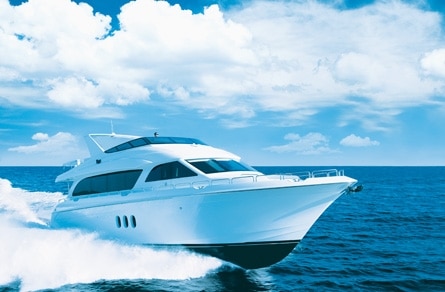
ytgjul08hatt72.jpg
Balance.
You know a boat has it at first glance. There’s something about how she sits in the water and the way your eye is drawn to the nuance of profile, window and portlight shape, and, if she has an upper deck, the way it sits in the right proportions to the one below it.
And then there are the subtleties. Such as how the aft end of the bridge deck naturally follows the line down to the overhang on the lower deck. It’s also an awareness of how the gentle flare of the forward bulwarks and the sheer line, as they meet and drift aft, complement one another.
Such were my first impressions as I walked along the quay at the Pier 66 Marina in Ft. Lauderdale, to meet hull number two of the Hatteras 72 Motoryacht. Hull number one had already been delivered to her new home in California and number three was currently hosting her owners and guests at Key Largo’s Ocean Reef Club before cruising the Bahamas. Numbers four through six were at various ports along the east coast. Seems the 72 model line has been enjoying a bit more than a brisk interest level since its introduction in late 2007. That’s because the Hatteras design team, including architect Bruce Angel, Manager of Design Services David Willoughby, and Manager of Lamination Operations Bob Arthur know that achieving successful balances in design and construction techniques starts with a high degree of consistency.
“The 72 found its place in our lineup after the 64-, 80-, and 100-foot motoryacht designs. And with this hull, we decided it was the right time for infusion,” said Willoughby, who along with Hatteras’s Director of Marketing Eric Cashion, would accompany me aboard. “Eventually we see all of our hulls as infused product,” added Cashion. As for why this was the right time, both Willoughby and Cashion gave me some insight.
Given the success Hatteras experienced with the 60 GT Convertible, the first hull-infusion project the company took on, infusing the 72 was the natural next step. And as the tooling wasn’t ready for the 80, she was in the right place at the right time. But our discussion on the infusion process would have to wait, as Hatteras skipper Capt. Jack Frauenheim was ready to ease us out of a rather tight slip.
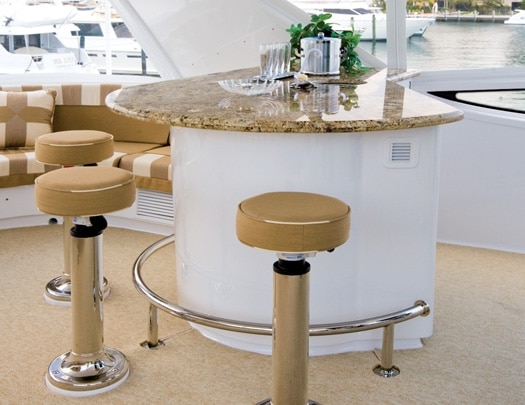
| | |
Willoughby, Cashion, and I were topsides and left the cushy surroundings of the beamy centerline helm area for the wide-open spaces of the aft portion of the bridge-empty now but with plenty of room for a dinghy up to 16 feet long to accompany the upgraded Steelhead Marine 1500 davit-in three-stool bar just aft and to port, and a pair of seating areas, one behind the bar and another to starboard. Just outside and to port of where we now stood, a large cabinet with a double Gaggenau barbecue on the opposite side definitely made this an area designed with entertaining as well as skippering in mind. My 72 had the hardtop with full EZ2CY enclosures, but even with the integral design, featuring a solid-glass section forward, or fully enclosed bridge, I would expect to find the same exceptional 360-degree views.
With all lines off, Frauenheim, standing at the deck’s aft docking station, gently nudged both of the 1,550-horsepower Cat C32 diesels turning a pair of eight-blade Nibral 40×70 wheels through deep-geared ZF 4:1 transmissions. He slid us back some to allow the bow to not only clear the forward pilings, but the bow of the stern-to docked sportfisherman sticking out into the narrow channel as well. Using a bit of port and starboard now and then, in tandem with the optional stern and standard bow thruster, the 72 was smartly ‘walked’ off the dock until we were clear.
While leaving the marina offered the chance to display the biting power of those big wheels, I was looking forward to the enjoyment that lay ahead. We joined the procession of small, large, and mega vessels in the Intracoastal, passed under the 17th Street Causeway Bridge, and after hanging that familiar turn to port, made for the open ocean and my first, and only, disappointment of the day. “It’s flat calm,” I said.
“Yep. That it is,” answered Frauenheim standing next to me at the wheel topsides, a wry smile tugging the corners of his mouth. “I guess it’s Bimini for lunch then,” I said. His smile got a little broader and he just nodded.
It was still early enough in the morning to consider making that happen-my sea trial averaged a solid 20-knot cruising speed, sufficient for the 50-plus-mile run across-but as she was being shown to a prospective client later that afternoon I resigned myself to spending my time aboard in the most productive way possible. With Frauenheim at the wheel, I set out to get familiar with the Hatteras 72 Motoryacht.
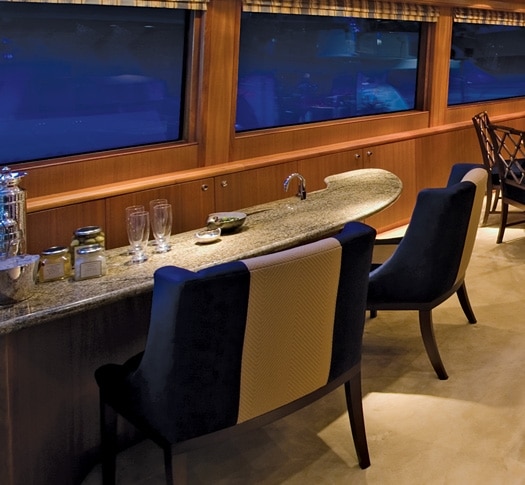
| | |
My first stop was the main salon that, even though the boat has walk around decks, still provides a big volume interior by maximizing the 20-foot, 2-inch beam. Adding to the roominess are three large windows to either side allowing plenty of ambient light to flood in. While hull number two’s beautiful woodwork was finished off in high-gloss cherry, African mahogany or maple are also available, as is a satin finish. And, as I experienced, whether sitting at the optional bar to port, the starboard couch or club chair, or at any one of the dining table’s six chairs, there are great views available through the windows or via the automatic sliding-glass door aft. In addition, just behind the bar is a convenient stairway to the lazarette, crew quarters, and engineroom.
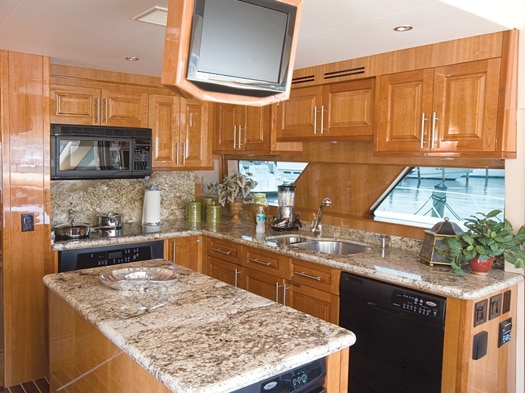
| | |
As the galley always occupies a special place aboard big cruising boats, Hatteras made sure the 72’s country kitchen layout was not only well equipped with all the requisite appliances but also utilized a wealth of space for counters, including a large island, cabinets, drawer space, and stowage areas. Case in point, the sizable roll-out pantry next to the full-size Sub-Zero refrigerator. This useful addition takes its depth from beneath the starboard stairway leading from the galley to the bridge and is a practical and useful application of otherwise dead space. And while this boat was equipped with the optional galley day-head, the room can be configured as an additional walk-in pantry. The large forward windows are also appreciated, as is the pair of aircraft-style doors on each side, making access in and out of the area safe and easy.
The 72 comes standard with a three-stateroom, three-head layout with a forepeak, a VIP port stateroom with athwartships berth, and full-beam master amidships, all accessed via a wide staircase forward on the galley’s starboard side. I found all the quarters to be tastefully decorated with lots of attention to detail and most importantly, outfitted with enough drawer, closet, and stowage spaces for extended cruising. In fact, I counted 32 individual drawers between the master suite’s two built-ins. That’s in addition to a pair of large cedar-lined lockers-including a walk-in aft and to starboard. Other features in the accommodations area include closeted side-by-side washer and dryer units in the hallway and, on our boat, an optional over/under stateroom to starboard. “With this space, we can deliver this fourth stateroom or we can move the owner’s door forward and create an office, breakfast room, or even another walk-in closet,” Cashion said.
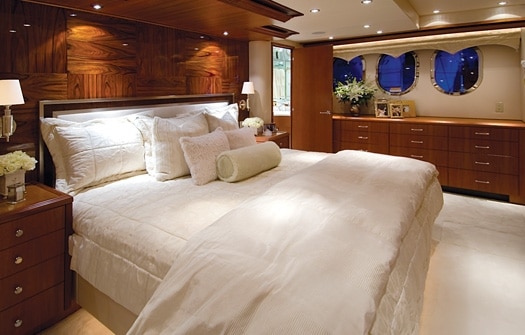
| | |
After several runs to get a handle on the 72’s performance numbers, we sat back and enjoyed the comfortable sea conditions. “The development of this boat’s bottom has directly benefited from our sea-proven convertible designs,” said Willoughby as we motored several miles offshore of Ft. Lauderdale. The 72 has a deep-V forward section for a smooth, clean entry that transitions to a convex bottom and then flattens out in the aft part of the running bottom for proper planing. Add a pair of deep pockets and you have a big, comfortable cruising boat with the soul of a horizon-chasing battlewagon under your feet. “Everything that is applicable on our convertibles, from the 54 to the 68, as far as rough-water capabilities you may need on passages, has been built into this boat,” said Willoughby.
As the day wore on, time became a factor and we had to head back to the dock so the boat could have a quick cleanup before her late afternoon appointment with a prospective owner. That also gave me the opportunity to check out the engineroom.
I entered through the swim platform’s aft door and was greeted by a sizable stateroom to port and directly opposite, a full head with shower, both spaces decorated and detailed in the same fashion as I found in the staterooms. Just forward of the head is a washer and dryer and just in front of the engineroom door, a large freezer compartment for provisioning those long cruises. “We can also do something interesting down here as well,” noted Cashion referring to the fact that Hatteras can create a separate stateroom area here by closing off the hallway with a door.
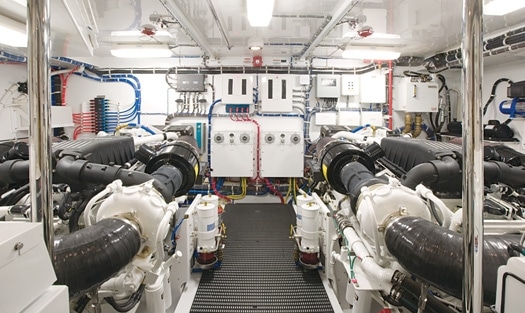
| | |
The engineroom really shows off the design team’s ability to create a well-balanced space that is in harmony with the rest of the boat. There’s a big enough footprint to upgrade to 1,800-horsepower Cat C32 Acerts or 1,800-horsepower MTU 12V 2000 CRs and still have plenty of room for the hands-on owner or skipper to work on both inboard and outboard sides of the powerplants. In addition, every piece of vital equipment or system is completely accessible. And of particular note was how relatively cool the space was after running, due mostly to the excellent air-handling system that features intakes on the inboard side of the outer decks topside instead of the usual ones found seaside on many other boats.
While I missed putting her through some rough-water handling, I found the Hatteras 72 Motoryacht to be yet another fine example of the company’s ability to balance design, engineering, and the maximum use of both interior and exterior space with the latest construction techniques. The result is a big, comfortable cruising boat that is more than capable of delivering everything her owners and their guests expect. Hatteras Yachts, (252) 633-3101; www.hatterasyachts.com









